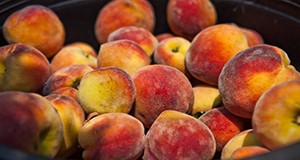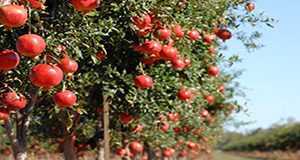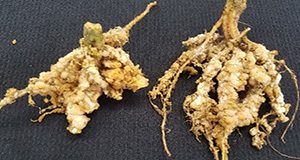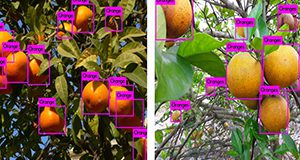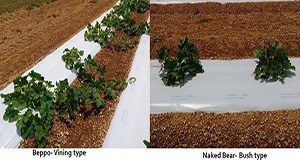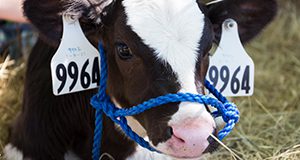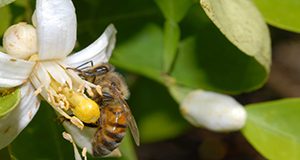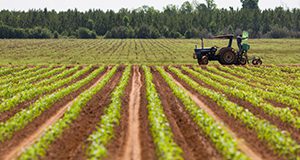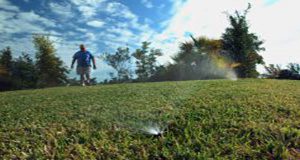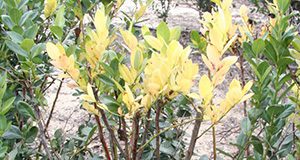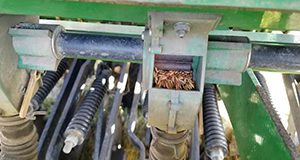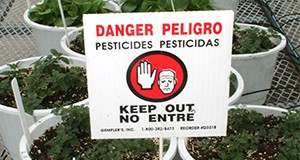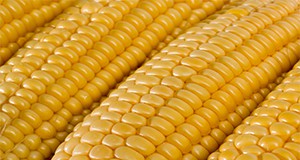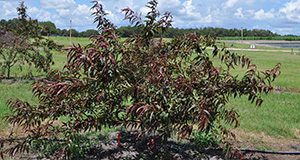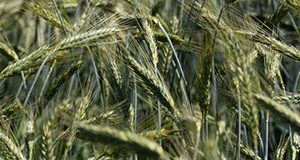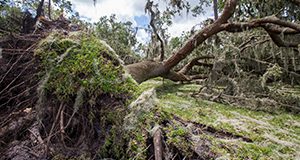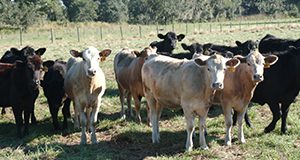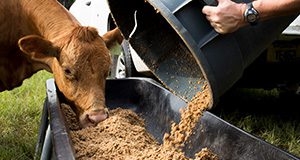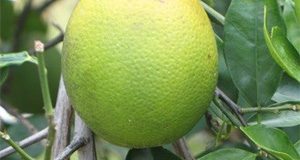
Citrus greening, or huanglongbing (HLB), is a bacterial disease that affects citrus trees’ vascular systems, limiting nutrient uptake. As trees become increasingly affected by the disease, they suffer premature fruit drop, the fruit harvested is smaller and misshapen, and the juice quality is compromised, all resulting in lower yield. To this date there is no cure or successful management strategy to deal with HLB. This 8-page fact sheet written by Ariel Singerman, Marina Burani-Arouca, and Stephen H. Futch and published by the UF/IFAS Food and Resource Economics Department summarizes the results of an analysis of three tree densities under different production and market conditions to determine which density is most profitable.
http://edis.ifas.ufl.edu/fe1050
Category: Agriculture
Thinning Florida Peaches for Larger Fruit
Fruit size is an important factor in a fruit crop’s marketability. This 6-page document discusses fruit thinning, a process that is critical to achieving larger-sized peaches, and thus is critical to the success of peaches grown in Florida. Written by Yuru Chang, Ali Sarkhosh, Jeffrey Brecht, and Peter Andersen and published by the UF/IFAS Horticultural Sciences Department, January 2018.
http://edis.ifas.ufl.edu/hs1324
The Pomegranate
This 6-page document profiles the pomegranate and discusses its production in Florida. Written by Ali Sarkhosh and Jeff Williamson and published by the UF/IFAS Horticultural Sciences Department, January 2019.
http://edis.ifas.ufl.edu/mg056
Nematodes Parasitizing Hops in Florida
The growth of Florida’s craft beer industry has created new opportunities for Florida growers to establish commercial hop (Humulus lupulus) operations. However, many challenges including several nematode species make the establishment of this industry difficult. This 4-page fact sheet written by Johan Desaeger and published by the UF/IFAS Department of Entomology and Nematology describes nematodes that prey on hops and suggests some strategies for preventing nematode damage to safeguard this emerging industry.
http://edis.ifas.ufl.edu/in1229
Applications of Artificial Intelligence for Precision Agriculture
Technological advances in computer vision, mechatronics, artificial intelligence, and machine learning have enabled the development and implementation of remote sensing technologies for plant, weed, pest, and disease identification and management. They provide a unique opportunity for the development of intelligent agricultural systems for precision applications. This 5-page document discusses the concepts of artificial intelligence (AI) and machine learning and presents several examples to demonstrate the application of AI in agriculture. Written by Yiannis Ampatzidis, and published by the UF/IFAS Department of Agricultural and Biological Engineering, December 2018.
http://edis.ifas.ufl.edu/ae529
Yield and Horticultural Performance of Naked-Seed Pumpkin in South Florida
Pumpkin seeds with a thin or soft seed coat are called naked seeds, and are a popular ingredient in many snacks, breads, breakfast cereals, soups, and other edible goods. This 5-page document reports on yield and horticultural performance of two naked-seed pumpkin cultivars under south Florida spring growing conditions. Written by Geoffrey Meru and Yuqing Fu and published by the UF/IFAS Horticultural Sciences Department, December 2018.
http://edis.ifas.ufl.edu/hs1323
Are Cows Comfortable in Modern Dairy Facilities?
The main challenge of modern large dairy operations is to achieve high milk yield per cow without sacrificing health and welfare. Properly designed and managed facilities allow calves, heifers, and cows to be comfortable and successfully grow, mature, maintain health, and reach peak performance. This 8-page document discusses facilities, cow comfort, resting behavior, feed and water access and availability, stocking density, and heat stress. Written by Izabella Toledo, and published by the UF/IFAS Department of Animal Sciences, December 2018.
http://edis.ifas.ufl.edu/an349
Florida Honey Bee Plants
Climate, plant communities, and timing of floral resources differ significantly between north, central, and south Florida. While many plants are acceptable pollen producers for honey bees, fewer yield enough nectar to produce a surplus honey crop. The tables in this 12-page fact sheet written by Mary Christine Bammer, William H Kern, and Jamie D. Ellis and published by the UF/IFAS Entomology and Nematology Department list the nectar-bearing plants that are present to some degree in each region and the bloom times for each plant.
http://edis.ifas.ufl.edu/in1223
Farm Business Start-Up Checklist for Northeast Florida
This 12-page fact sheet written by Kevin Athearn and Jennifer Johns and published by the UF/IFAS Food and Resource Economics Department lists steps for starting a farm business in Northeast Florida, along with resources and contact information to assist a new farmer with completing each step.
http://edis.ifas.ufl.edu/fe1042
Blueberry Frost Protection Practices in Florida and Georgia
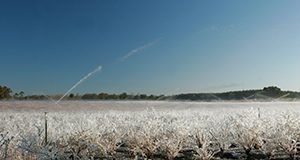
Written by Tatiana Borisova, Elizabeth Conlan, Erick Smith, Mercy Olmstead, and Jeffrey Williamson and published by the UF/IFAS Food and Resource Economics Department, this publication was developed to assist professionals attempting to establish a benchmark for when to use frost protection in blueberry production. This benchmark can assist in developing outreach strategies to educate producers about frost protection strategies, and it can also help measure changes in their frost protection behavior over time.
http://edis.ifas.ufl.edu/fe1045
An Overview of Florida Water Policy Framework and Institutions
Written by Jarrett Davis, Tatiana Borisova, and Michael T. Olexa and published by the UF/IFAS Food and Resource Economics Department, this publication provides a background on the history of laws and regulations governing water use in Florida and an overview of those laws.
edis.ifas.ufl.edu/fe1043
Algal Stem Blotch in Southern Highbush Blueberry in Florida
Algal stem blotch has become a significant disease on southern highbush blueberries (SHB) in Florida. This 3-page document aims to guide Florida blueberry growers through the identification and management of this disease. Written by Douglas Phillips, Norma Flor, and Phillip Harmon and published by the UF/IFAS Plant Pathology Department, November 2018.
http://edis.ifas.ufl.edu/pp344
Calibrating Forage Seeding Equipment
Establishing forages from seeds often requires precision equipment to achieve specific seeding rates for a proper pasture stand. Most pieces of equipment have calibration charts, which are useful guides for making an initial setting. However, due to variations in seed size, purity, moisture content, equipment performance, ground speed, and other factors, calibrating equipment prior to each use is recommended. This 5-page document discusses a few calibration techniques for drills and broadcast spreaders. Written by Marcelo Wallau, Joao Vendramini, and Ed Jennings, and published by the UF/IFAS Agronomy Department, revised November 2018.
http://edis.ifas.ufl.edu/ag158
New Paraquat Requirements
This 2-page document addresses the mitigation measures being undertaken by the EPA which will become new labeling requirements for paraquat (one of the most widely used herbicides registered in the United States) products. Written by Frederick M. Fishel and published by the UF/IFAS Agronomy Department, November 2018.
http://edis.ifas.ufl.edu/pi279
Be on the Lookout for Bacterial Leaf Streak of Corn
Bacterial leaf streak (BLS) is a new corn disease that has been found in several major corn-producing regions of the United States. This 3-page document describes the identification and management of BLS. Written by Kevin Korus and Nicholas Dufault and published by the UF/IFAS Plant Pathology Department, November 2018.
http://edis.ifas.ufl.edu/pp341
Rootstocks for Florida Stone Fruit
Rootstocks are used in many tree fruit systems to provide growth advantages and/or pest and disease resistance without affecting (sometimes improving) productivity and fruit quality. This 6-page document discusses the use of rootstocks for Florida stone fruit. Written by Ali Sarkhosh, Mercy Olmstead, Jose Chaparro, and Thomas Beckman and published by the UF/IFAS Horticultural Sciences Department, November 2018.
http://edis.ifas.ufl.edu/hs366
A Walk on the Wild Side: 2018 Cool-Season Forage Recommendations for Wildlife Food Plots in North Florida
Nationally, there is great interest in wildlife forages. Florida's light and sandy soils, hot and humid summers, and seasonal droughts pose unique challenges for successful food plot plantings. This 5-page document provides updated cool-season forage recommendations for wildlife food plots in north Florida. Written by A. R. Blount, M. Wallau, H. K. Ober, E. Rios, J. M. B. Vendramini, J. C. B. Dubeux, Md. A. Babar, C. L. Mackowiak, and K. H. Quesenberry, and published by the UF/IFAS Agronomy Department, revised November 2018.
http://edis.ifas.ufl.edu/ag139
Hurricane Impacts on Florida's Agriculture and Natural Resources
Hurricanes are capable of affecting almost everything in their paths. Their strong winds and heavy rains can directly impact both inland and coastal areas in short periods that usually last about a day. This new 10-page document reviews basic facts about hurricanes and their effects in Florida and discusses ways they might affect Florida's agriculture and natural resources. Written by Young Gu Her, Ashley Smyth, Pamela Fletcher, Elias Bassil, Ulrich Stingl, Zachary Brym, and Jiangxiao Qiu, and published by the UF/IFAS Department of Agricultural and Biological Engineering, October 2018.
http://edis.ifas.ufl.edu/ae528
Forage-Based Heifer Development Program for North Florida
Developing replacement heifers to become productive females in the cow herd is a tremendous investment in a cow-calf operation that takes several years to make a return. Fortunately, there are several options to develop heifers on forage-based programs that can help reduce costs while meeting required industry performance targets. This new 4-page document proposes a model for replacement heifer development based on forage research trials at the UF/IFAS North Florida Research and Education Center (UF/IFAS NFREC) in Marianna, FL. Written by Jose Dubeux, Nicolas DiLorenzo, Kalyn Waters, and Jane C. Griffin, and published by the UF/IFAS Agronomy Department, October 2018.
http://edis.ifas.ufl.edu/ag424
Methods of Trace Mineral Supplementation
The forage cattle consume as the bulk of their diet is often deficient in trace mineral concentrations. Cattle producers can choose from a number of different methods to provide supplemental trace minerals to cattle. This 3-page document discusses several common ways to provide trace mineral supplements as well as their advantages and disadvantages. Written by Matt Hersom and Todd Thrift, and published by the UF/IFAS Department of Animal Sciences, October 2018.
http://edis.ifas.ufl.edu/an348
